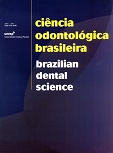Evaluation of the marginal adaptation of ceramic copings in function of the
DOI:
https://doi.org/10.14295/bds.2003.v6i4.537Resumo
This study evaluates the marginal adaptation of ceramic copings (In-Ceram, Vita) front of two finish lines andinternal surface treatment (Rocatec, ESPE). For this, two master steel dies were milled with all-ceramic crowns
preparation, one with a round shoulder (RS) margin design, and the other with a deep chamfer (DC). Twenty
copings were made, and the marginal discrepancy was evaluated in measuring microscope, obtaining an initial
measure. Each group was divided in two others, which received two kinds of silica sandblasting: (1) in all inner
crown surface - DCt and RSt - and (2) in the inner crown surface, but preserving the cervical edge - DCa and
RSa. The discrepancies were measured again and the data submitted to the statistical analysis. Marginal discrepancy
values of 42,37±18,78μm were observed for group DC and 33,35±20,08μm for group RS in the initial
measures, without significant statistical differences among them. The initial and final gap values were compared
to each one of the experimental groups, being observed statistical differences in DCa and DCt. Statistical differences
was not observed among the post-sandblasting values. It was concluded that both cervical endings present
similar marginal adaptations between them when not submitted to any treatment type. When accomplished
the surface treatment, negative influence was observed in the marginal adaptation of some groups, if compared
the initial and final values, in spite of differences among the last ones were not been observed.
Downloads
Downloads
Publicado
Como Citar
Edição
Seção
Licença
TRANSFERÊNCIA DE DIREITOS AUTORAIS E DECLARAÇÃO DE RESPONSABILIDADE
Toda a propriedade de direitos autorais do artigo "____________________________________________________________________" é transferido do autor(es) para a CIÊNCIA ODONTOLÓGICA BRASILEIRA, no caso do trabalho ser publicado. O artigo não foi publicado em outro lugar e não foi submetido simultaneamente para publicação em outra revista.
Vimos por meio deste, atestar que trabalho é original e não apresenta dados manipulados, fraude ou plágio. Fizemos contribuição científica significativa para o estudo e estamos cientes dos dados apresentados e de acordo com a versão final do artigo. Assumimos total responsabilidade pelos aspectos éticos do estudo.
Este texto deve ser impresso e assinado por todos os autores. A versão digitalizada deverá ser apresentada como arquivo suplementar durante o processo de submissão.




























